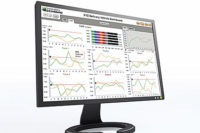Integrating Systems
A new model integrates standardization requirements and other management systems.

Many companies have adopted internationally recognized management systems for quality performance. More recently, they are doing the same for environmental and health and safety performance as well. While the intention is to ensure robust and auditable systems, most companies end up with two, three or even more separate systems to address multiple functionalities. These separate systems can compete for resources and time demands, especially in smaller organizations.
To help overcome these challenges, Gabriel Performance Products and the Society of Chemical Manufacturers and Affiliates (SOCMA) recently announced the ChemStewards® Integrated Management System (IMS), a Microsoft Access-based tool that combines these systems into a single comprehensive management system. Gabriel has been a member of the Washington, D.C.-based trade group since 2001.
“Combining management systems in our facility has helped us leverage all the similarities in the various standards,” said Tyce Workman, EHS manager at Gabriel. “We now have one system to track corrective and preventive actions that can be managed by one person or one department, whether the action is quality, safety, or even general production issues.”
Gabriel took the ChemStewards system and overlaid the International Organization for Standardization (ISO) requirements for its 14001, 9001 and Occupation Health and Safety Assessment Series (OHSAS) 18001 system. The result is a single written manual that covers all requirements for the system. “The ChemStewards system provided us the framework from which to build,” said Workman. “This system is a Plan, Do, Check and Act management tool that maintains organizational accountability, adaptability, and applicability.”
The basis of the IMS is a first-level set of policies that defines the scope of the system. The next tier of documents includes procedures detailing activities governed by the standards. The final tier includes forms, logs and records that contain data required by the standards. While this approach is not novel, all functionalities use the same group of policies, procedures and forms to make this approach more efficient. For instance, management of change is typically a safety functionality. With the Integrated Management System, management of change is used throughout the organization to document and communicate quality, environmental and process changes, as well as safety-specific changes. The same theory holds true with document control, audits, communication, training and all other cross-functionalities.
The database is also invaluable to management representatives of the systems. Data can easily be pulled for reporting and paretoing for statistical analysis. Incidents can be tracked by area, process and people; they can also be assigned costs and severity. This allows both quality and EHS staff to pinpoint problem areas and assign projects to alleviate them.
The database also features a risk assessment tool that uses a Failure Mode and Effects Analysis (FMEA) approach to identify environmental, safety, quality, and product stewardship risks. After risks are scored, high-level aspects can be assigned projects to lower the overall risk.
Another significant advantage, according to Gabriel, includes a reduction in audit times for both customers and outside agencies. Using a central database for procedures, compliance deadlines, action items, change management, and other functionalities allows for quick and timely access to data to present to auditors. It allows for easy retrieval of proof that the organization is following the standards, be they customer- or regulation-driven.
“We are excited to be able to share what we have learned with SOCMA members,” said Ken Allen, Gabriel’s president. “We feel best practice is sharing benefits-not just within Gabriel but with the industry as a whole. We hope that this tool will continue to grow and improve with input from all ChemStewards members.”
In May 2011, Gabriel presented the Integrated Management Database concept and demonstrated the database tool at the EHS&S and Sustainability National Conference, sponsored by ChemStewards, in Houston, TX. The ChemStewards team is in the process of making the tool available at no charge for all SOCMA members.
For additional information, contact Gabriel Performance Products at 725 State Rd., Ashtabula, OH 44004; phone (440) 992-3254; fax (440) 992-3204; or visit www.gabepro.com. SOCMA’s website is located at www.socma.org.

Many companies have adopted internationally recognized management systems for quality performance. More recently, they are doing the same for environmental and health and safety performance as well. While the intention is to ensure robust and auditable systems, most companies end up with two, three or even more separate systems to address multiple functionalities. These separate systems can compete for resources and time demands, especially in smaller organizations.
To help overcome these challenges, Gabriel Performance Products and the Society of Chemical Manufacturers and Affiliates (SOCMA) recently announced the ChemStewards® Integrated Management System (IMS), a Microsoft Access-based tool that combines these systems into a single comprehensive management system. Gabriel has been a member of the Washington, D.C.-based trade group since 2001.
“Combining management systems in our facility has helped us leverage all the similarities in the various standards,” said Tyce Workman, EHS manager at Gabriel. “We now have one system to track corrective and preventive actions that can be managed by one person or one department, whether the action is quality, safety, or even general production issues.”
System Foundations
The foundation for the Integrated Management System is ChemStewards, SOCMA’s environmental, health, safety and security program. ChemStewards promotes the improvement of employee safety, employee and community health, the reduction of a facility’s environmental footprint, and the continuous enhancement of a facility’s security.Gabriel took the ChemStewards system and overlaid the International Organization for Standardization (ISO) requirements for its 14001, 9001 and Occupation Health and Safety Assessment Series (OHSAS) 18001 system. The result is a single written manual that covers all requirements for the system. “The ChemStewards system provided us the framework from which to build,” said Workman. “This system is a Plan, Do, Check and Act management tool that maintains organizational accountability, adaptability, and applicability.”
The basis of the IMS is a first-level set of policies that defines the scope of the system. The next tier of documents includes procedures detailing activities governed by the standards. The final tier includes forms, logs and records that contain data required by the standards. While this approach is not novel, all functionalities use the same group of policies, procedures and forms to make this approach more efficient. For instance, management of change is typically a safety functionality. With the Integrated Management System, management of change is used throughout the organization to document and communicate quality, environmental and process changes, as well as safety-specific changes. The same theory holds true with document control, audits, communication, training and all other cross-functionalities.
Data Support
Supporting the IMS manual is a database that allows transparent communication and retrieval of data. Key parts of the database include incident investigation, new chemical approval, a calendar for regulatory and other requirements, management of changes, a projects tracker, supplier and vendor management, and an employee dashboard. The dashboard serves as a central interface to allow employees access to other functionalities. From this, all employees and their supervisors can see specific assigned actions, investigations, approval requests, calendar items and change requests. This allows immediate accountability and action-item tracking by having one place to track what is due, when it’s due and what has been done.The database is also invaluable to management representatives of the systems. Data can easily be pulled for reporting and paretoing for statistical analysis. Incidents can be tracked by area, process and people; they can also be assigned costs and severity. This allows both quality and EHS staff to pinpoint problem areas and assign projects to alleviate them.
The database also features a risk assessment tool that uses a Failure Mode and Effects Analysis (FMEA) approach to identify environmental, safety, quality, and product stewardship risks. After risks are scored, high-level aspects can be assigned projects to lower the overall risk.
Another significant advantage, according to Gabriel, includes a reduction in audit times for both customers and outside agencies. Using a central database for procedures, compliance deadlines, action items, change management, and other functionalities allows for quick and timely access to data to present to auditors. It allows for easy retrieval of proof that the organization is following the standards, be they customer- or regulation-driven.
Implementation
Gabriel spent about six months and roughly $100,000 developing this tool to help companies better manage their systems. In January 2011, Gabriel presented the Integrated Management Database concept to SOCMA to share with all member facilities.“We are excited to be able to share what we have learned with SOCMA members,” said Ken Allen, Gabriel’s president. “We feel best practice is sharing benefits-not just within Gabriel but with the industry as a whole. We hope that this tool will continue to grow and improve with input from all ChemStewards members.”
In May 2011, Gabriel presented the Integrated Management Database concept and demonstrated the database tool at the EHS&S and Sustainability National Conference, sponsored by ChemStewards, in Houston, TX. The ChemStewards team is in the process of making the tool available at no charge for all SOCMA members.
For additional information, contact Gabriel Performance Products at 725 State Rd., Ashtabula, OH 44004; phone (440) 992-3254; fax (440) 992-3204; or visit www.gabepro.com. SOCMA’s website is located at www.socma.org.
Links
Looking for a reprint of this article?
From high-res PDFs to custom plaques, order your copy today!





